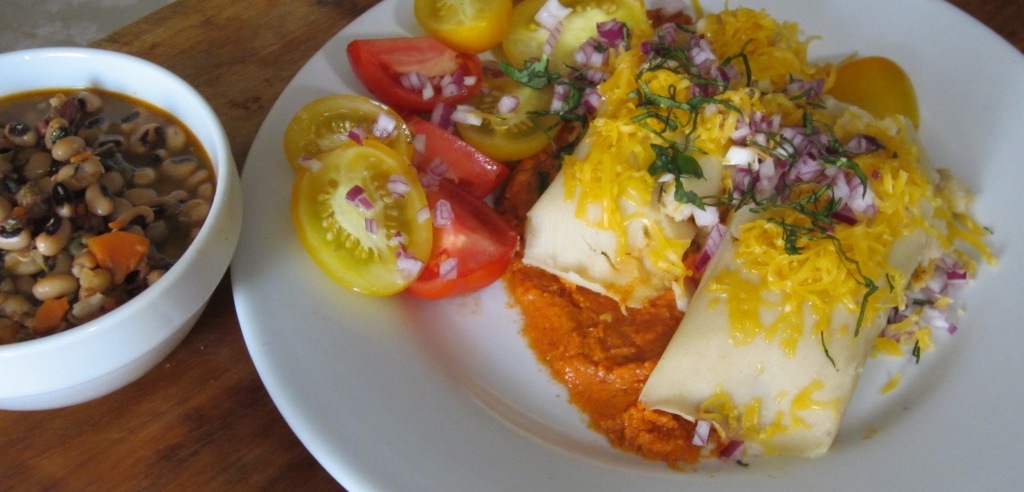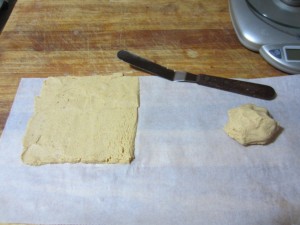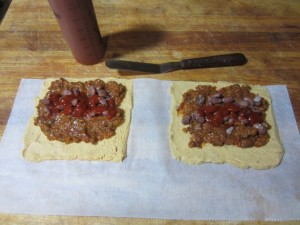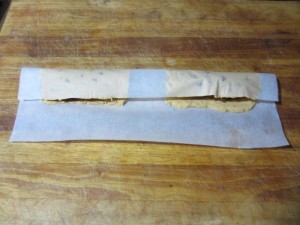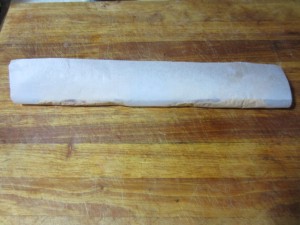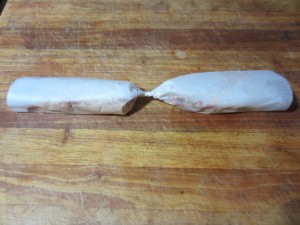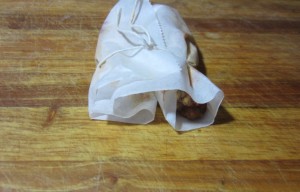Update: Want to go totally wrapper free? Check out my later post on “stacked” tamales.
You’ve heard me bemoan the lack of Mexican food here in my corner of Canada before so I’ll spare you that misery again and just say that when you have a craving for tamales and can’t find either corn husks or masa flour, you still have options. For ages I’ve heard everyone who delves into the topic say how labour intensive tamale making is and what a herculean effort they are to make. While traditional all-day-long tamalada parties with a dozen friends slinging masa dough around can be a hoot, I make a small batch of these for myself as an evening meal regularly with hardly any fuss at all. Mine also happen to be vegetarian most nights but the technique works just as well for carnivores.
While the traditional dried corn husks typically used as tamale wrappers in Mexico work perfectly well after a good soak in warm water, much of Canada has a shortage of supply on that front. Strange since we grow bucket loads of corn but the locals don’t think to harvest the husks here in our tamale-free culture. If you have a stash secreted away by all means use them but thankfully some tests in my own kitchen have shown that parchment paper can easily serve the same purpose with just a bit of practice. Many will tell you that the flavour is more authentic using the corn husks and while that would technically be true since parchment doesn’t grow up out of the ground in Oaxaca, I can confirm that taste tests made with exactly the same recipe and varying only the wrapper made little difference in the final flavour on the plate. Looking back into tamale history peppered with Aztec and Mayan examples, you can even see that corn husks were often supplanted by other wrappers of opportunity like banana leaves.
With all that corn dough and spicy filling, I think husk taste claims to the contrary are nostalgic rather than genuinely detectable by all but the most seasoned tamale eaters. I’ve found too that depending on your dough makeup, parchment releases the finished tamales better than traditional corn husks albeit without the fun visual ridges left by the latter method. Indeed modern commercially-made tamales have long ago switched to paper wrappers. If you have a decent sauce, you’ll never know the difference.
For more tamale heresy to rile up aficionados of the authentic recipes, you can visit the history of the deep south in America and look to their waves of Italian immigrants for Mississippi River Delta ‘hot tamales’ made with the more widely available corn meal. Finer than polenta grind, it isn’t as fine as the more authentic Mexican masa harina but certainly in every pantry of the area for making their ubiquitous cornbread. Traditional Mexican masa flours are made with nixtamaized corn which also has a different flavour thanks to the extra processing – think tortilla chips versus cornbread – but different doesn’t always mean better or worse. There’s room in my tamale world for a touch of both.
If you CAN find masa flour, you’re already ahead of the game for texture and flavour. There are versions for tortillas and versions for tamales but from what I can tell the only difference there is in the grind. I can get tortilla grade examples even in my local snowbound stores so that’s what I use most often but tests with a bag of the tamale grind from far flung mail order sources made almost no difference to my palate. I have also developed an affinity for a small amount of the coarser texture given by pure cornmeal in the “delta” style so my usual mix is some portion of ordinary cornmeal mixed with a ratio of masa harina. This ratio can be fiddled with as much as you wish but if you don’t have ANY masa flour, you’ll need to add a few tablespoons of corn starch to soak up extra liquid and help bind the tamale dough.
Most tamale pundits will gleefully inform you that you must, must, must have lard to make the tamales authentic. They’re correct but that doesn’t automatically exclude delicious from less traditional recipes. I’ve made my masa dough with pure vegetable shortening for as long as I can remember, even before I became mostly vegetarian. A quick survey of recipes out there will tell you that butter can be substituted too. This is also true but in my taste tests they were quite frankly too buttery. Tamales really shouldn’t taste like pastry in my opinion. Any reasonable fat that’s solid at room temperature should work fine to give you an acceptable mouth feel and if you want to formulate your own ratio of butter to vegetable shortening to coconut oil to Burmese spotted monkey tree oil to any other whacky substitute, go right ahead. Not being a full-force vegan, I’ve not experimented with such voodoo. Vegetable shortening alone works just fine for me and my vegetarian ways.
Speaking of vegetarian, I get plenty of satisfaction using the mushroom, onion, sweet corn, and chile version of filling below. You might think that sweet corn inside would be maize overkill but remember that sweet corn is a different animal entirely from the flint corn that makes up your masa or cornmeal. You could play around with all sorts of roasted squash or root veg in there too and of course any decently tender pot of beans will work perfectly well. The spicing is what pulls them all into the realm of tamale filling. If you’re a true carnivore and need a dose of slow-simmered pork or shredded chicken, the rest of the tamale techniques are just the same as are most of the spices. Just make sure your filling is cooled before you assemble so the tamales cook evenly.
Cheese is another logical favourite for tamales and I’m all for heaps of the stuff but rather than adding it to the filling where it might make the tamales more apt to fall apart, I save it for topping after they’ve cooked when I can smother them in a rich tomato or chile sauce at the same time. I’ve even gone dairy mad and stirred up a creamy sauce made with any number of Mexican cheeses included. Horribly nontraditional that is but pretty tasty just the same.
Before diving into forming the tamales themselves, I find it helpful to portion out both my dough and filling for consistency. You want to make sure you get good masa to filling balance but remember that your dough will expand somewhat during steaming. Spreading the masa thin no matter what wrapper you use is the mark of a good tamale maker. At the very least use a measured amount for each tamale by consistently scooping or spooning the volume each time. Your amounts might vary but I find that fifty grams of masa and two heaping tablespoons of filling works just about perfectly in the method below. Your tamale mileage may vary.
For tamale forming technique on parchment paper in the old-fashioned ‘open end’ method, the photo progression below is worth a few thousand words. Basically take a four inch by fifteen inch (or however wide your roll is) piece of parchment and spread two thin squares of masa dough using an offset spatula (diagram below). Leave a few inches border between, below, and outside the squares. Place your filling in the middle of the squares leaving a short border of masa uncovered on the bottom edge and then fold the top edge (A) to the bottom edge of the filling (B) allowing the masa border and empty parchment border to overlap the opposite side. The natural curl of the parchment off the roll should help with this somewhat. Twist the parchment roll that now contains two tamales twice in the centre to seal the ‘inside’ end and fold the two tamales together to leave the ‘open’ end upright. Tie bundles of several ‘double tamale’ rolls together so you can stand them open end up for thirty minutes over a steamer at full boil. Use empty (cleaned) tins from the recycle bin if you need some extra support on smaller batches that don’t quite match your available steamer real estate. Snip the ties and the centre twists of parchment after steaming with a pair of kitchen shears for easier unwrapping.
Optionally, you can fold single tamales made in the centre of eight-inch parchment squares so that both ends are closed like an envelope and cook them laying flat on a steamer. 
Speaking of steamers, I have a traditional tamale pot that was pennies at my local mercado when I lived in a more tamale friendly neighbourhood. They have a metal insert that rests at the bottom of the lightweight pot with larger perforations to allow the steam to rise through (see photo below). I’ve also made tamales in my Asian bamboo steamer by stacking them flat and even used a cheap expandable steamer insert in a stockpot at a friend’s house in a tamale pinch. The point is the tamales don’t care what steam generating device you use but arrange accordingly to prevent blowouts in whatever gizmo you have on hand.
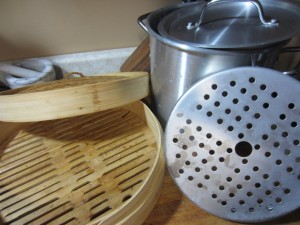
Vegetarian Tamale Dough
Vary the ratio of masa to cornmeal to suit your textural tastes. Any solid fat (butter, coconut oil, lard, etc.) will work but pure vegetable shortening is my choice.
3/4 cup masa flour, any grind available to you locally *
1/4 cup cornmeal *
50g vegetable shortening
1 teaspoon salt
1 teaspoon Tex-Mex spice mix (see below)
200 ml water
* If you only have regular cornmeal available to you, use an equivalent amount but add two tablespoons cornstarch to the mix. These will taste quite different than those made with masa but still very good.
Yield: Enough for 6 – 8 tamales. Recipe can be multiplied as many times as will comfortably fit into your processor and you have time to form tamales.
In food processor fitted with a standard cutting blade, pulse all ingredients except water until shortening is cut in well. Add water and process until combined into a wet dough. Allow to sit ten minutes before use.
Vegetarian Tamale Filling
Cutting the potatoes by hand and adding them last helps maintain an interesting texture to the final filling.
225g (8 ounces) mushrooms, any variety, freshly washed
1 medium onion, any variety
2 jalapeno peppers, stemmed, de-seeded, and veins removed (substitute hotter or milder chiles to taste)
fresh sweet corn kernels cut from 2 medium ears (or substitute one 341ml / 12 ounce can, drained)
1 medium russet potato, peeled
1 tablespoon oil
2 teaspoons Tex-Mex spice mix (see below)
fine sea salt to taste
Yield: Filling for roughly 16 tamales
In a food processor fitted with a standard cutting blade, process the mushrooms to a fine chop and set aside. Process the onion and pepper similarly. Cut the potato by hand to a fine quarter-inch dice. Cook the potato in boiling salted water until they’re barely tender but still hold their shape, roughly five minutes, then drain completely.
In a large saucepan over medium heat, add the oil and spices and stir until fragrant, about a minute. Add the mushrooms, onions, and peppers and saute until the onions are translucent and the mushrooms begin to give off their moisture, about six minutes. Add the corn and potatoes, salt to taste, and warm through about three minutes longer stirring only occasionally to avoid mashing the potatoes. Allow to mostly cool before assembling tamales.
Quick Tamale Sauce (or try my Taco Sauce thinned with tomato puree / juice and warmed gently)
1 tablespoon butter or oil
1 teaspoon spice mix (see below)
Salt to taste
1 cup vegetable or chicken stock
2 teaspoons nutritional yeast (optional)
2 teaspoons corn starch dissolved in 4 tablespoons cold water
Yield: Approximately one cup of sauce. Can be safely doubled or tripled.
Add butter or oil to a small saucepan with the spices. Heat over medium just until fragrant, about a minute, stirring often. Add salt, stock, and yeast whisking well to combine. Bring to a low simmer then drizzle in the corn starch slurry while raising the temperature to almost boiling and whisking constantly until thickened, about two minutes.
All-purpose Tex-Mex Spice
Any measuring device will work as this is mixed by volume not weight. Note that I do not include salt preferring to add that to dishes as needed on a case by case basis. There’s always a jar of this waiting on my shelf. It should be on yours too.
4 parts sweet paprika
1 part whole black pepper
1 part whole cumin seed
1 part dried oregano (Mexican varieties preferred)
1 part pure chile flake or powder, hot or mild to preference (NOT a blended chili powder)
1/2 part garlic granules (NOT garlic salt)
Combine all and grind to a fine powder only as needed in a small electric coffee mill.
V2.5

